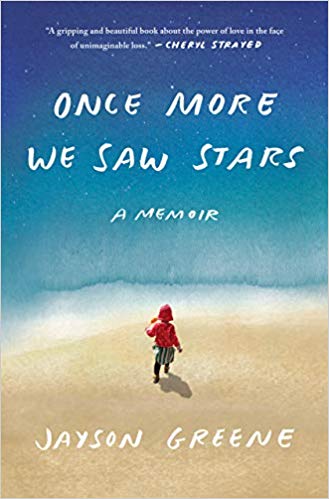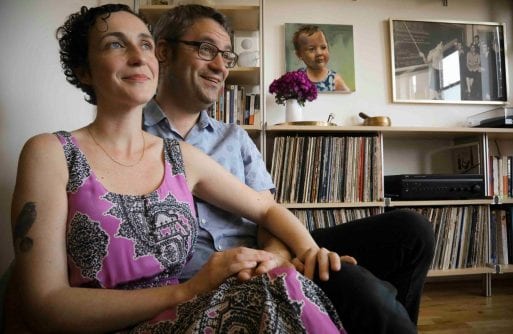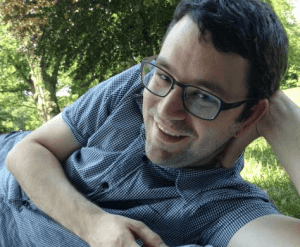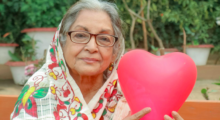 “Once More We Saw Stars” by Jayson Greene describes agonizing pain, the difficulties of grief and the impact that love has on all of us. At its surface, his new memoir recounts the terrible accident that killed his young daughter: the grief, the anger, the insanity of it all. But, ultimately, “Once More We Saw Stars” offers the reader hope for the power of love in the wake of unimaginable tragedy.
“Once More We Saw Stars” by Jayson Greene describes agonizing pain, the difficulties of grief and the impact that love has on all of us. At its surface, his new memoir recounts the terrible accident that killed his young daughter: the grief, the anger, the insanity of it all. But, ultimately, “Once More We Saw Stars” offers the reader hope for the power of love in the wake of unimaginable tragedy.
Jayson and his wife Stacy lived through one of the more horrible experiences a parent could deal with. Their two-year-old daughter Greta was struck in the head by a brick that fell from an eighth-story window sill in New York City. Greta was with her grandmother, Stacy’s mother Susan, sitting on a bench when the horrific incident occurred. The sheer randomness of it all is haunting.
This is how “Once More We Saw Stars” begins. The book is divided into six sections, with the first recounting the accident. The memoir rolls in chronological order, from Greta’s accident through to the birth of their son, Harrison. This extraordinarily personal account is a blend of sadness, humor, new-found spirituality, anger and iterations of love. It runs the gamut of emotions and describes the healing processes of both Jayson and his loved ones.

Stacy and Jayson Greene with a portrait of Greta behind them
Credit: dallasnews.com
Jayson Greene details the importance of our family and friends during painful times throughout “Once More We Saw Stars.” He also does a wonderful job of not solely focusing on himself, being sure to acknowledge everyone else’s grief around him. In one poignant passage about Greta’s ceremony, he writes:
As the ceremony goes on, I can sense the accumulated weight of our grief in the room and our power in sharing it. We are passing through some sort of magnificent, terrible threshold together.
The parents are probably the people most of us would think of first after a young child dies. Her death was certainly most life-altering for Jayson and Stacy. (Jayson does acknowledge that Susan, the grandmother who was with Greta when she was struck, has never been the same and has overwhelming feelings of guilt.) But Jayson Greene does not forget that his daughter’s death greatly affected everyone in his social circle.
Visions of Greta
One tool Greene uses throughout “Once More We Saw Stars” is the weaving of reality and visions he has of Greta. As any parent would, he imagines all of the things she didn’t get to do, the places she never got to see. But he also details times where he feels her presence, speaks and “interacts” with her.
For instance, Jayson Greene goes running for the first time in the park following Greta’s death. And as he enters the park:
There at the park’s mouth, my heart stirs, and I feel a peculiar elation. I recognize her. Greta is somewhere nearby. I feel her energy, playfully expectant. Come find me, Daddy, she says. Tears spring and run freely down my face. I hear you, baby girl, I whisper. Daddy’s coming for you.
It’s then that he enters, and eventually sees her under a tree. He’s reminded of a game they used to play. He runs over to her and picks her up, even though he’s really only grabbing air. To the passersby in the park, he probably looked a little crazy. But post-bereavement hallucinations are not uncommon. Jayson eventually tells her that he’s going on a run, and she says, “Oh yeah, OK!” He describes numerous visions such as this throughout “Once More We Saw Stars.”
The Power of Personal Narrative
Jayson Greene’s ability to make readers feel his emotions is abundant throughout the memoir. I found myself smiling, frowning and tearing up many times. Having an emotional reaction to the written word is a wonderful experience. And it certainly helps when it is balanced, not relying on one emotion in particular.
There are parts of “Once More We Saw Stars” that are hard to get through. This is the case for any personal narrative about the death of a loved one. It’s somewhat odd to be an outsider thrust into the mind of a stranger regarding such a private matter. But authors write memoirs like this to help those struggling, to show that perhaps we’re not all that dissimilar.

Author Jayson Greene.
Credit: bkmag.com
Many different people in different places in life would benefit from reading “Once More We Saw Stars.” Expecting and new parents would certainly benefit from the “never take a day for granted” message the book seems to espouse. Making sense of suffering, finding ways to deal with grief and discovering spirituality are all touched on. The delicate balance of family structures during periods of sorrow is also broached.
I could imagine that this book may be difficult for people whose young child has died recently. I’m sure Jayson Greene touches on many raw feelings that people in similar situations might not be able to handle. But he also offers many ideas that people would find useful. It’s beneficial to know that you’re not alone in an experience as tragic as the death of a child.
Ultimately, I think anyone who is interested in the grieving process, the importance of family and friends, and the power of love through dark times would enjoy “Once More We Saw Stars.”

 “Once More We Saw Stars,” by Jayson Greene
“Once More We Saw Stars,” by Jayson Greene


 “Summons” by Aurora Levins Morales
“Summons” by Aurora Levins Morales
 How To Dispose of a Body In Space
How To Dispose of a Body In Space
 AMA Adopts New Policies Expanding Access to Palliative Care
AMA Adopts New Policies Expanding Access to Palliative Care














